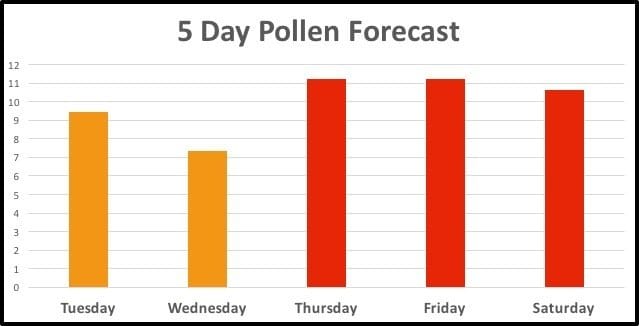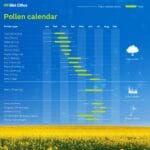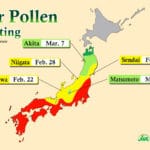Spring brings beautiful blooms to Columbus, Ohio, but for many, it also ushers in the dreaded allergy season. If you’re one of the many residents battling sneezes and itchy eyes, understanding Columbus’s unique pollen patterns and resources can be your key to relief.
Decoding Columbus’s Pollen Forecast
While the specific pollen forecast fluctuates, staying informed is crucial. Websites and apps like AccuWeather and Pollen.com provide real-time data, helping you plan your day. For a deeper dive into historical trends and analysis, IQAir is a valuable resource. But remember, knowledge is power! Always check multiple sources, as pollen counts can vary.
As of today, October 20th, AccuWeather reports:
- Tree Pollen: Low
- Ragweed Pollen: Low
- Grass Pollen: Low
- Mold: Low
- Dust & Dander: Very High
Don’t Let Dust & Dander Steal the Show: Even when pollen counts are low, other allergens like dust mites and pet dander can thrive, especially during specific seasons. Regularly cleaning your home and managing pet dander can make a significant difference.
Columbus’s Seasonal Allergy Lineup
Columbus experiences a trifecta of allergens – tree pollen, grass pollen, and ragweed – each taking center stage during different times of the year.
- Springtime’s Tree Pollen Explosion: Starting as early as March or April, tree pollen, particularly from oak, maple, and birch, can make its presence known. This onslaught often continues into early summer.
- Summer’s Grass Pollen Dominance: As the weather warms up, grass pollen takes over, reaching its peak in late spring and lingering throughout the summer months.
- Fall’s Ragweed Reign: Just when you think you can breathe easily, ragweed pollen emerges in late summer and dominates throughout the fall.
Weather’s Influence on Your Allergies
Columbus weather is notorious for its unpredictability, and these fluctuations directly impact pollen levels.
- Temperature’s Role: As temperatures rise, pollen production increases. A warm spell can quickly send pollen counts soaring.
- Humidity’s Impact: High humidity can exacerbate allergy symptoms, making the air feel thick and heavy. However, a good rain shower can temporarily clear pollen from the air.
- Wind as a Pollen Distributor: Wind acts as pollen’s mode of transportation. Calm days generally offer respite for allergy sufferers, while windy days can spread pollen far and wide.
Pro Tip: Analyze historical weather and pollen data for Columbus. You might uncover patterns, such as specific weather conditions that precede high pollen counts.
Why Are My Allergies So Bad in Ohio?
Ohio’s climate and plant life create a perfect storm for allergy sufferers. The state’s long growing season allows ample time for trees, grasses, and weeds to release pollen. Add in warm temperatures and humidity, and you have ideal conditions for pollen to thrive.
But it’s not just the outdoors! Indoor allergens like dust mites and mold also flourish in Ohio’s climate.
Microclimates: Columbus’s Hidden Pollen Hotspots
Columbus has unique neighborhoods and microclimates, meaning pollen levels can vary significantly within the city. Areas with dense tree populations, parks, or even high traffic zones might harbor higher pollen concentrations. Paying attention to how your allergies feel in different parts of the city can be incredibly insightful.
Beyond the Forecast: Understanding Your Individual Sensitivities
Pollen forecasts provide valuable information, but remember that everyone reacts differently. What sends one person reaching for tissues might not faze another.
Pay attention to your body! Keep a symptom journal to identify potential triggers. Do your symptoms worsen in specific locations or during certain activities? This information can help you make informed decisions about your exposure.
Take Control of Your Allergies
Don’t let allergies dictate your life! Columbus offers resources and strategies to help you manage your symptoms:
- Consult a Healthcare Professional: Talk to your doctor about your allergies. They can recommend personalized treatment plans, including over-the-counter remedies, prescription medications, or immunotherapy (allergy shots).
- Embrace Indoor Comforts: On high-pollen days, consider limiting outdoor activities, especially during peak pollen times. Keep windows and doors closed and use air purifiers with HEPA filters to improve indoor air quality.
- Plan Outdoor Activities Strategically: If you’re venturing outside, check the pollen forecast and choose times when pollen counts are lower, such as after a rain shower.
- Post-Activity Clean-Up: After spending time outdoors, shower and change your clothes to remove any lingering pollen.
Navigating Allergies in Columbus
Remember, managing allergies is an ongoing process. By staying informed, proactively planning, and seeking professional guidance, you can take control of your health and enjoy all that Columbus has to offer – without the sniffles and sneezes holding you back!
- Unveiling Bernhard Caesar Einstein’s Scientific Achievements: A Legacy in Engineering - July 15, 2025
- Uncover who is Jerry McSorley: CEO, Family Man, Business Success Story - July 15, 2025
- Discover Bernhard Caesar Einstein’s Scientific Contributions: Unveiling a Legacy Beyond Einstein - July 15, 2025















